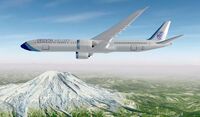Oriental Airlines
 | |||||||
| |||||||
| Founded | 1946 | ||||||
|---|---|---|---|---|---|---|---|
| Hubs | O’polis International Airport | ||||||
| Secondary hubs | |||||||
| Focus cities | |||||||
| Destinations | Europa, Thalassa, Marenesia | ||||||
| Headquarters | O’polis | ||||||
| Key people | Bertrand Tingus (CEO) | ||||||
| Revenue | |||||||
| Employees | 24,826 (FY 2017) | ||||||
| Website | www.flyoriental.io | ||||||
Oriental Airlines (Oharic: Irentawi Ayeri), often known as OA, is the flag carrier of Orioni. In 2016, Oriental Airlines managed to carry some 7.7 million passengers, or 21,000 passengers each day, making it a sizeable airline in Europa measured by scheduled passengers flown. Together with several partners in the Star Alliance, it operates an extensive route network on Eurth.
History
Founding and early years
Oriental Airlines was founded on 12 February 1946, initially named Oriental Airways. Founded near the end of the Thalassan War, it was a period when the aviation industry began seeing an unprecedented boom and an increased need for connectivity. The airline's founders envisioned creating an air bridge that connected the heart of Europa to the broader regions of Eurth.
Initially operating out of Zuidhaven, a strategic port city, the airline started with a handful of propeller-driven aircraft. By focusing on domestic routes in its initial years, it rapidly gained popularity, particularly among business travellers seeking faster modes of transport across Orioni.
A !Boeing 314 Clipper flying low.
Merging and expansion
By the early 1950s, with increasing competition and the advent of jet aircraft, Oriental Airlines felt the need to consolidate. In 1953, it merged with Andro Air, a popular regional airline known for its punctual services. This merger allowed the combined entity to leverage the strengths of both airlines, resulting in a broader route network and an expanded fleet.
1954 was a watershed year for the airline. The company, now equipped with a few jet aircraft, decided to venture internationally. Their inaugural international service was launched to Tamurin. The success of this route led to rapid international expansion, opening doors to destinations in neighbouring continents over the next decade.
Shift to O'polis and modern era

The late 1960s saw another significant move for Oriental Airlines. With the growth of O'polis as a global metropolis and the inauguration of the O’polis International Airport, the airline moved its primary hub from Zuidhaven to O'polis. This strategic move positioned the airline at the crossroads of major intercontinental routes, allowing it to serve a broader clientele and expand its route network further.
Throughout the 1980s and 1990s, Oriental Airlines embraced technological advancements, modernising its fleet with the latest aircraft and adopting computerised reservation systems. The airline also launched its frequent flyer program in the 1990s, further cementing its relationship with its loyal customer base.
In recent times, the airline has continued to grow, not only in terms of its fleet size but also in its reputation for safety, service quality, and operational efficiency. Despite challenges faced by the aviation industry globally, the airline reported a notable profit in 2016, showcasing its resilience and adaptability.
Corporate affairs and identity
Headquarters
Oriental Airlines' headquarters is strategically located in O’polis, the pulsating heart of Orioni. This metropolitan city offers a nexus of connectivity, serving as a vital hub for international trade and communication. The modern and sprawling complex in O’polis not only houses the airline’s primary corporate and administrative functions but also boasts state-of-the-art training and innovation centres.
Key personnel
At the helm of Oriental Airlines' operations is its dedicated CEO, Mr Bertrand Tingus. Under his visionary leadership, the airline has embraced innovation, sustainability, and customer-centricity. Alongside him is a diverse team of industry veterans and innovative thinkers, ensuring the airline remains at the forefront of the aviation industry.
Branding and logo
The logo of Oriental Airlines, as depicted in "Logo-of-Oriental-Airlines.png," symbolises its rich heritage and ambitious forward trajectory. Comprising elements that reflect the fusion of Orioni traditions with modern design, it embodies the essence of the airline – a perfect blend of tradition and modernity.
The main colour palette used for the branding is inspired by the contrasting landscapes of Orioni, evoking feelings of trust, reliability, and strength. The airline's aircraft livery, stationery, and crew uniforms also incorporate these colours, ensuring brand consistency and instant recognisability.
Corporate responsibility
Oriental Airlines is deeply committed to its corporate social responsibilities. The airline undertakes numerous initiatives aimed at sustainability, environmental protection, and community outreach. From adopting fuel-efficient aircraft to supporting local communities through various educational and healthcare initiatives, the airline ensures its operations leave a positive mark on society and the environment.
In terms of environmental sustainability, the airline has invested in research and innovations aimed at reducing its carbon footprint. These include efficient flight routing, reducing onboard weight, and exploring alternative sustainable fuels.
Marketing and sponsorships
Over the years, Oriental Airlines has been an active participant in the world of sports, arts, and culture. The airline sponsors numerous events, including international sports tournaments, music festivals, and art exhibitions. These sponsorships play a dual role – promoting the brand on global platforms and supporting the enrichment of global cultural and sporting heritage.
Subsidiaries
While the main focus of Oriental Airlines is commercial passenger transport, the company has ventured into various related sectors through its subsidiaries. These range from cargo operations and in-flight catering to aircraft maintenance and holiday packages. These subsidiaries, while operating under the broad umbrella of Oriental Airlines, have their own set of objectives and deliverables.
Destinations
As of 2025, Oriental Airlines serves a multitude of destinations, spanning both within the country and across international borders. The airline, with its broad route network, strives to ensure that passengers experience seamless connectivity and convenience, whether travelling domestically or internationally. Oriental Airlines’ dedication to expanding its route network reflects in its operations, ensuring that passengers have more direct flights and greater flexibility.
Domestic
Oriental Airlines takes pride in its vast domestic network, ensuring that Orioni and its many vibrant cities are well-connected. The airline makes it easier for residents and tourists alike to explore the country's diverse landscapes and cultures. Key domestic destinations include:
International
Oriental Airlines' international presence spans across continents, providing passengers with the opportunity to explore various cultures, cuisines, and landscapes. Partnering with members of the Star Alliance also enables passengers to enjoy wider connectivity and hassle-free travel experiences. Here are some key international destinations:
 Andalla
Andalla Burkini
Burkini Cristina
Cristina Gotneska (only on weekends)
Gotneska (only on weekends) Ide Jima
Ide Jima Miiros
Miiros Rohini
Rohini Sunset Sea Islands
Sunset Sea Islands Tamurin
Tamurin
The airline is consistently evaluating and updating its routes based on market demand, ensuring that it offers the best options for its valued customers.
Fleet
Oriental Airlines operates a diverse fleet of aircraft tailored to serve both its short-haul domestic and long-haul international routes. The airline continually evaluates its fleet composition to ensure fuel efficiency, environmental responsibility, and passenger comfort. It takes pride in having one of the youngest fleets in the aviation industry, comprising state-of-the-art aircraft from leading manufacturers.
Current Fleet
Oriental Airlines' fleet includes several aircraft models, prominently featuring the Aérospatiale Magenta. The Magenta, produced by Lysian manufacturer Aérospatiale, is a long-haul widebody airliner known for its reliability, efficiency, and innovative design. It serves as the backbone of Oriental Airlines' long-haul operations, ensuring passengers travel in utmost comfort over great distances.
In addition to the Magenta, the airline operates a mix of other single-aisle and wide-body aircraft, allowing it to cater to various route lengths and passenger demands.
Fleet Renewal
In line with its commitment to sustainability and modernisation, Oriental Airlines has ongoing orders for the latest next-generation aircraft. These new planes are expected to offer improved fuel efficiency, reduced noise levels, and a superior passenger experience.
Cabin
Oriental Airlines offers various cabin classes tailored to fit the needs of every passenger:
- Economy Class: Designed for the budget-conscious traveller, yet without compromising on comfort or service. Each seat comes equipped with personal entertainment systems, ergonomic seating, and a complimentary meal service.
- Business Class: Offering more spacious seating, priority boarding, and enhanced meal options. Business travellers can also benefit from dedicated workspaces and access to the airline's lounges at select airports.
- First Class: An epitome of luxury, the first-class cabin offers unparalleled privacy, gourmet dining, and a personal flight attendant service. Seats can be converted into fully flat beds, ensuring a restful journey.
Services
Oriental Airlines continually strives to enhance its passenger experience. Beyond the in-flight amenities, the airline offers:
- Frequent Flyer Program: A loyalty program rewarding regular passengers with points that can be redeemed for flights, upgrades, and other exclusive benefits.
- In-flight Entertainment: A diverse range of movies, music, games, and informational programs in multiple languages.
- In-flight Wi-Fi: Allowing passengers to stay connected during their journey.
- Special Assistance: Dedicated services for passengers with reduced mobility, unaccompanied minors, and those with specific dietary requirements.
Accidents and incidents
Safety is paramount for Oriental Airlines, and it consistently ranks as one of the safest airlines globally. While the airline's safety record is commendable, like any major airline, it has experienced incidents over its long operational history:
- $date: A minor incident involving a landing gear malfunction resulted in no injuries, thanks to the skilled crew's timely response.
Details about specific incidents can be elaborated upon, based on provided data.
Notable employees
Over its extensive history, Oriental Airlines has been home to several employees who have left a significant mark:
- Bertrand Tingus: Serving as the airline's CEO, his leadership has steered the airline through challenging times, ensuring its continued success and growth.
- Aisha Lumumba: The airline's first female pilot, Lumumba broke barriers in a traditionally male-dominated field and inspired many women to pursue careers in aviation.
- Dev Patel: A long-serving flight attendant, Patel was awarded for saving a passenger's life mid-flight, demonstrating the airline's commitment to training its staff for emergencies.
References
- ↑ Oriental Airlines boasts 150 million profit “despite challenging year” (March 28, 2017)



